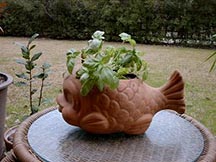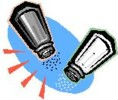Make the most of culinary herbs and spices.
Other articles you might enjoy:
2. An Herb Gardener's Diary--Part Four
4. An Herb Gardener's Diary--Part One
An Herb Gardener's Diary - Part 5
by Sandra Bowens
Here's one that's full of our favorite recipes because we wrote the book! It is also full of information, helpful hints and ideas for using herbs and spices in your kitchen.
Six months already since the last diary entry. The garden has seen some changes, plants have come and gone or made their seasonal transformations. A series of spring freezes did a bit of damage but all of the plants made it through the massive rains and wind we experienced when Tropical Storm Bill passed right over.
Update
The seeds I spoke of in part four netted variable results. Savory and thyme just never did take off but the parsley and chervil grew into lovely plants that are still growing now. A couple of the chervil plants bolted, or flowered early, but I found that interesting since I had never seen the delicate white flowers before.
Although I should have done more research before starting, the nasturtium seedlings grew into full plants with wonderful multi-colored flowers. The rapidly browning leaves and few flowers attest to the fact that they are actually a cool-weather plant better suited to the Southern winter. While they were vibrant I did use the radish-flavored leaves in salads and the flowers as an edible garnish.
Now that I have experimented a bit with starting herbs from seeds I have noticed that the plants I started directly in the pots where I want them to grow do better than those sown into peat pots. I just have not had much luck with transplanting the tiny seedlings. I have also noted that those seeds planted during suitable outdoor growing conditions do much better than those I have tried to start early indoors.
The basil plant that illustrates the diary series met an unfortunate end just days after the photograph was published. While most herbs are hardy into the low 40's (F.) basil can't take anything below 50 degrees. Need I say more?
New Additions
Besides yet another basil plant, I have found a number of herbs that are new to me as a gardener. I had never cooked with fresh chervil or savory until I had my own plants. They are both good for combining with other herbs. I hadn't even seen a live lavender plant until I bought one at a nursery. Unfortunately, that is another of our cool-season herbs and it promptly burnt up so I didn't get to see it flower. I did enjoy its delightful aroma for several weeks.
It's true what they say about spearmint growing quickly. Remember, this is the one that seasoned gardeners always plant in a separate pot because it spreads so fast. I did follow that advice but it still has tentacle-like stems beginning to crawl along the patio.
I snapped up a lemon balm plant at the farmer's market thinking that it was lemon verbena. Lemon balm is an odd herb with the strong scent of that lemon furniture polish. It's most often used for teas so I haven't really done anything with it yet.
One herb that I never cared much for is tarragon. Cooking with the fresh leaves is completely different than using it dried and I find the taste quite pleasant. Rosemary was the same way but I love it now.
Dill has always been my favorite herb. Because I trimmed so frequently from it while it was young, I have one crazy looking plant out there now. It is about two and a half feet tall but the feathery leaves are only at the top. I don't think I took cuttings from it properly! One interesting point to note with this plant is that as the main stalk flowered, signaling the finish of its season, another shoot came up from the base giving an expired herb new life. I am glad I didn't give up on it too soon.
Battling the Bugs
When it comes to outdoor plants each season brings certain challenges. Here in the Southern United States each season also brings certain bugs. Snails and slugs arrive as the weather warms in February and March. They tend to enjoy the ornamental plants and leave the herbs alone. Actually, I haven't had trouble with any sort of infestations in my herb plants.
Until this year, that is. We are having such a wet summer that the worm, caterpillar, etc. community is thriving. I have found armyworms of every size on all of my plants. Upon returning from an unexpected ten-day trip, I discovered few of the pests but plenty of their evidence in chewed leaves and bald stems.
This same wet weather is contributing to a general listlessness in the herb garden. With so little sun the plants aren't growing much. Some leaves are turning yellow, or in the case of oregano and that lemon balm reddish leaves are appearing. I haven't been able to give them the proper care like trimming and fertilizing since the weather is so poor. Not to mention all the rain breeds hungry mosquitoes.
Kitchen Excitement
One of the things I found most intriguing about The Herbfarm Cookbook is the recipe for the Herbfarm Salad. This restaurant is famous for serving artfully arranged salads that may contain as many as thirty different herbs. I decided to try this for a special meal. After a clipping session on the patio, I came up with 19 different ingredients for my salad. What fun!
I also find it fun to put herbs into recipes where people don't expect to find them. Just last month I took a batch of Rosemary Zaletti cookies (newsletter readers will remember this recipe) to a gathering of friends. After sampling these cornmeal sugar cookies everyone would try to guess that somewhat familiar flavor. Most suggested lemon but all were surprized when I revealed it was fresh rosemary. The mint pesto brownies at All About Mint are another treat that stumps people.
While entertaining on my patio I enjoy plucking leaves and asking my guests if they would like a sample. The nasturtiums received plenty of puzzled looks and the cherry tomato-basil leaf combination always gets a request for seconds.
It's not too late in the season for you to have fun with herbs. If you haven't already, get out there and start gardening!
Tips
1) Know the temperature limits of each plant to prevent unnecessary loss.
2) If you must go away for an extended period, try to find a garden-loving friend to monitor your plants for bugs and weather conditions as well as water levels.
3) Consider buying more than a single plant, or get a larger, well-established one, if you want to cook with that herb frequently. Remember, never clip more than a third of the foliage at a time.
4) Plant and tend to more seeds than you think you will want because some won't make it and you can always thin the plants later.

A handy and highly-recommended reference for growing herbs, vegetables and edible flowers on your deck or patio. See aPinchOf.com's review of this book.
Straight from the experts with a bonus chapter of stunning photos and information about the National Herb Garden in Washington, D.C.

A luscious book from the Herbfarm kitchen-nursery filled with unusual ideas for using fresh herbs. See aPinchOf.com's review of this book.
The Sweet Herb is hot! This tiny tome shows you how to grow the pretty little plant called stevia and then what to do with it once you have a harvest.






